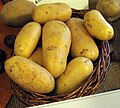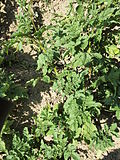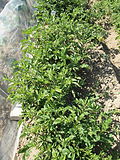| Name | Image | Country of origin | Year of introduction | Notes |
|---|
| Adirondack Blue |  | United States | 2003 | |
| Adirondack Red |  | United States | 2003 | |
| Agata |  | Netherlands | 1976 | |
| Agria [ de ] |  | Germany | 1985 | |
| Ajanhuiri [ es ] |  | Bolivia | | |
| Almond |  | Sweden | | |
| Alpine Russet | | United States | 2009 | |
| Alturas | | United States | 2002 | |
| Amandine |  | France | 1993 | |
| Allians |  | Germany | 2003 | |
| Amarilla | | Peru | | |
| Amflora |  | | 1996 | Cultivation was initially permitted in Europe, but was later prohibited in 2013. [1] |
| Andean black |  | | | |
| Annabelle | | Netherlands | 2001 | |
| Anuschka |  | Germany | 2004 | |
| Anya | | Scotland | 1996 | |
| Arran Victory |  | Scotland | 1918 | |
| Atlantic |  | United States | 1978 | |
| Atlas |  | | | |
| Augusta |  | Germany | | |
| Austrian Crescent | | | | |
| Avalanche | | United Kingdom | 1989 | |
| Baccara |  | | | |
| Bamberg |  | Germany | 1819 | |
| Bamberger |  | Germany | 1819 | |
| Banana | | Canada | 1990 | [2] |
| Bannock Russet | | United States | 1999 | |
| Barbara |  | Germany | 1982 | |
| Belana |  | Germany | 2000 | |
| Bellarosa |  | Germany | 2004 | |
| Belle de Fontenay |  | France | 1885 | |
| Berlichingen |  | Germany | 1927 | |
| BF-15 | | | | |
| Bildtstar | | Netherlands | 1984 | |
| Bintje |  | Netherlands | 1904 | |
| Bionta |  | Austria | 1993 | |
| Black Champion | | Ireland | | |
| Blaue Hindelbank |  | | | |
| Blaue St. Galler |  | Switzerland | | |
| Blaue Uttenwill |  | | | |
| Blaue Viola |  | | | |
| Blaue Vogtländer |  | | | |
| Blazer Russet | | United States | 2005 | |
| Bloomer | | Ireland | 1936 | |
| Blue Bell |  | France | 2008 | |
| Blue Christie |  | | | |
| Blue Congo [ de ] |  | | | Also known as 'Blue Swede' or 'Idaho blue', the Blue Congo was voted the German "potato of the year" in 2006. [3] |
| Bojar |  | Czechoslovakia | 1945 | |
| Bonnotte [ fr ] |  | France | | |
| Brambory |  | | | |
| British Queen | | Scotland | 1894 | |
| Butte | | United States | 1977 | |
| Cabritas | | Chile | 1889 | |
| Camota | | | | |
| Camel | | Netherlands | 2013 | Red |
| Canela Russet | | United States | | |
| Cara | | Ireland | 1973 | Maincrop, blight resistant |
| Carola | | Germany | 1979 | |
| Champion | | Scotland | 1863 | |
| Charlotte | | France | 1981 | Salad, blight resistant |
| Chelina | | | | |
| Chérie |  | France | 1997 | |
| Cheyenne |  | France | 2011 | |
| Chiloé |  | | | [4] |
| Ciclame |  | | | |
| Cielo | | | | |
| Clavela Blanca | | | | |
| Colette |  | Germany | 1995 | |
| Corte |  | Andahuaylas, Peru | | |
| Cream of the Crop | | | | From South America. Purple skin, slight whitish scab, blue when cooked. [5] |
| Cultra |  | Ireland | 1986 | [6] |
| Cyrano | | Netherlands | 2003 | Origin of 'Cyrano' is the result of a cross made in 1991 between 'Goldstar' and HO86E423 at HZPC, Metslawier, the Netherlands. |
| Dejima |  | Japan | 1971 | [7] |
| Désirée |  | Netherlands | 1962 | |
| Doré |  | Netherlands | 1939 | |
| Dos Color |  | | | |
| Duke of York |  | United Kingdom | 1891 | |
| Dutch Cream | | | | [2] |
| Early Fortune | | Newfoundland | 1820s | Possibly developed by Ann Hulan |
| Edelgard |  | | | |
| Edzell Blue |  | Scotland | | |
| Eigenheimer | | Netherlands | | |
| Electra | | | | |
| Ennstaler Alpe |  | | | |
| Espirit |  | | | |
| Estima | | | | |
| Ewelina |  | | | |
| Fenton |  | | | |
| Fianna | | | | |
| Filea |  | | | |
| Fingerling |  | | | |
| Finka |  | | | |
| Flava |  | | | |
| French Fingerling | | | | |
| Gala |  | | | |
| German Butterball | | | | |
| Golden Wonder | | Scotland | 1906 | |
| Goldrush | | | | |
| Hansa |  | | | |
| Heideniere |  | | | |
| Hela |  | | | |
| Hermanns Blaue |  | | | |
| Hermes | | Austria | | |
| Highland Burgundy Red |  | Scotland | 1930s | |
| Holtgaster Blaue |  | | | |
| Home Guard | | Scotland | 1942 | |
| Huayro |  | Peru | | |
| Imilla |  | Bolivia | | |
| Industrie |  | | | |
| Innovator [ de ] | | | | |
| Irish Cobbler |  | | | |
| Irish Lumper | | | | |
| Irish White | | Ireland | 1882 | |
| Jam |  | | | |
| Jazzy |  | | | |
| Jeanie Deans | | | | |
| Jelly | | | | |
| Jersey Royal |  | Jersey | 1880 | |
| Jubel |  | | | |
| Juliette |  | | | |
| Kennebec |  | United States | 1941 | |
| Kerr's Pink | | Scotland | 1907 | |
| Kestrel |  | | 1992 | |
| Keuka Gold | | | | |
| King Edward |  | United Kingdom | 1902 | |
| Kipfler | | Germany | | [2] |
| Kitaakari |  | Japan | 1987 | [7] |
| Kuhbauch |  | | | |
| Lady Balfour | | | | |
| Lady Rosetta | | | |
| Langlade | | | | |
| Laura |  | Austria | 1998 | |
| Lenape | | United States | 1967 | |
| Lima |  | | | |
| Linda potato [ de ] |  | | | Was voted German "potato of the year 2007". [3] |
| Linzer Blaue |  | | | |
| Linzer Delikatess |  | | | |
| Linzer Rose |  | | | |
| Linzer Speise |  | | | |
| Linzer Stärke |  | | | |
| Marabel |  | | | |
| Marcy | | United States | 1990 | |
| Marfona | | Netherlands | 1975 | |
| Maris Peer | | United Kingdom | 1962 | [8] |
| Maris Piper |  | United Kingdom | 1966 | [9] |
| Marquis | | | | |
| Mayan Queen |  | | | |
| May Queen |  | Japan | | [7] |
| Megachip | | | 1985 | |
| Melody |  | | | [10] |
| Miss Blush |  | | | |
| Mizen | | Ireland | 1978 | |
| Monalisa |  | | | |
| Mozart potato | | | | |
| Mahil potato |  | | | |
| Lil key potato |  | | | |
| Negra Andina |  | Peru | | |
| Nadine | | | | |
| Navan | | Northern Ireland | 1987 | Bred from Maris Piper. Well suited for frying. [11] [12] |
| Nicola |  | | | It was voted German "potato of the year 2016". [3] |
| Nishiyutaka |  | Japan | 1978 | [7] |
| Norddeutsche Inseln |  | | | |
| Norgold Russet | | | | [13] |
| Oldenburger Blaue |  | | | |
| Opperdoezer Ronde |  | Netherlands | | |
| Orchestra | | | | |
| Ostbote |  | | | |
| Ozette |  | | | |
| Pachacoña | | Chile | | |
| Parel |  | | | |
| Pentland Crown | | United Kingdom | | |
| Peruanische Blaue |  | | | |
| Pike | | United States | 1996 | |
| Pink Eye | | Tasmania, Australia | | |
| Pink Fir Apple |  | France | | |
| Piruanita | | Cusco, Peru | | |
| Präsident Krüger |  | | | |
| Primura | | | | |
| Princess |  | | | |
| Professor Wohltmann |  | | | |
| Puca Quitish |  | | | |
| Puikula |  | | | |
| Quarta |  | | | |
| Ranger Russet | | United States | 1991 | |
| Ratte |  | | | |
| Record | | | | |
| Red Britain |  | | | |
| Red Gold | | Canada | 1970s | |
| Red La Soda | | United States | 1948 | |
| Red Norland |  | United States | | |
| Red Pontiac | | United States | | |
| Reichskanzler |  | | | |
| Remarka | | | | |
| Rooster |  | Ireland | 1990 | |
| Rosalind |  | | | |
| Rosenerdling |  | | | |
| Roseval |  | | | |
| Roslau |  | | | |
| Royal Blue | | | | |
| Rua | | New Zealand | | [14] |
| Runa | | Bolivia | | |
| Ruby Lou | | | | |
| Russet Burbank |  | | 1902 | |
| Russet Norkotah | | | | |
| Russian blue |  | Russia | | |
| Sapphire | | | | |
| Sebago | | | | [2] |
| Sechswochenkartoffel |  | | | |
| Selma [ de ] | | Germany | 1972 | |
| Sharpes Express |  | | | |
| Shepody | | | | |
| Shetland Black |  | Scotland | | |
| Sieglinde [ de ] |  | Germany | 1938 | Was voted as German "potato of the year 2010". [3] |
| Sigma |  | | | |
| Silverton Russet | | | | |
| Sirco | | | | |
| Skerry Champion | | Scotland | 1922 | |
| Snowden | | | | |
| Solara |  | | | |
| Spunta |  | | | |
| Stobrawa | | Poland | | |
| Superior | | United States | 1962 | |
| Svenungas Blaue |  | | | |
| Sylvana | | | | Parentage: Fabula x Xantia |
| Tannenberg |  | | | |
| Tennaer |  | | | |
| Toya |  | Japan | 1992 | [7] |
| Tūtaekurī | | New Zealand | | [15] |
| Tyson | | | | Cross: Sylvana x Cyrano |
| UACH 0918 |  | | | |
| UACH 0964 |  | | | |
| UACH 0965 |  | | | |
| Ulster Emblem | | Ireland | 1966 | |
| Umatilla Russet | | United States | 1998 | |
| Urberger |  | | | |
| Victoria [16] | | | | |
| Villetta Rose | | United States | 1994 | |
| Vineta [ pl ] |  | | | |
| Viola |  | | | |
| Violette d'Auvergne |  | | | |
| Violine de Borée |  | | | |
| Vitelotte |  | France | | |
| Vivaldi | | Netherlands | | |
| Warba | | | | |
| Weißauge |  | | | |
| Yellow Finn | | | | |
| Yukon Gold |  | Canada | 1965 | |



















































































































































